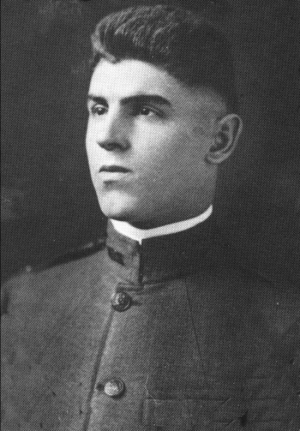
Lane Schofield Anderson was born February 14, 1896 in Richmond, Virginia to Justin K. and Fannie Anderson. He attended schools in Mercer, Mingo and Kanawha counties in West Virginia.
He graduated from Charleston High School in 1916. He excelled in track, becoming the first West Virginian to run the 100 yard dash in 10 seconds. He was a student at West Virginia University for a short time before entering Camp Benjamin Harrison for Officers Training, later being commissioned a Second Lieutenant. He married Julia L. de Gruyter on February 13, 1918. They had one child.
Lieutenant Anderson went overseas as a member of Company G, 26th Infantry, 27th Division. While in France he served under British Field Marshal Sir Douglas Haig. This company took part in the Battle of Argonne and broke through the Hindenburg Line.
The testimony of men who served with Lieutenant Lane Anderson attests to his bravery in battle after taking command when the leader of his platoon was killed. Under heavy enemy fire, Anderson left his safe position to lead his men to their objective and was wounded. Various accounts were given to his family as to the exact manner of his death. By some accounts he died shortly after, but other reports state he was captured and died in a German prison. His official date of death is September 7, 1918.
In a sworn deposition given March 5, 1919, Sergeant Harry S. Lynk, a comrade of Lane Anderson stated that during the initial stages of their attack on the Hindenburg line, two platoons of Company G lost contact. In order to regain contact, Lieutenant Lane Anderson, braving heavy enemy fire, did reconnaissance in an effort to locate the men of the platoons of Company G. It was discovered that they had enough men to hold their front line position. Captain Hardy, who had been in command, was killed and full command fell to Lieutenant Anderson.
Enemy forces were on both flanks and Anderson made the decision that the position should be “put out of action” in order to spare the remaining men. Sergeant Lynk stated that it was “sure death to show yourself” and related how Anderson “jumped up on the top Himself” while firing a rifle and “loaded down with bombs” in an effort to lead his men to a safer position. At this time, Lane Anderson was wounded by machine gun bullets. “For this and other acts of bravery,” said Sergeant Lynk, “I Know Lt. Anderson should receive the highest decoration that could be awarded by any government.” Sergeant Lynk, who himself had been awarded the Distinguished Flying Cross for bravery in the same battle, believed Lieutenant Lane Anderson more worthy of recognition than himself.
Lane Schofield Anderson was buried in Somme American Cemetery in Bony, France. For his bravery, he was awarded the Distinguished Service Cross posthumously. The award was presented to his widow, Julia L. Anderson. A VFW post was later named for him.
We honor you, Lane Schofield Anderson.
